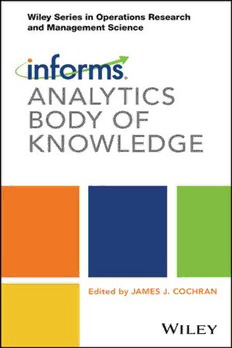Table Of ContentINFORMSAnalyticsBodyofKnowledge
Wiley Essentials in
OPERATIONALRESEARCHANDMANAGEMENTSCIENCE
INFORMS Analytics Body of Knowledge
Edited by James J. Cochran
This edition first published 2019
2019 John Wiley and Sons, Inc.
All rights reserved. No part of this publication may be reproduced, stored in a retrieval system,
or transmitted, in any form or by any means, electronic, mechanical, photocopying, recording or
otherwise, except as permitted by law. Advice on how to obtain permission to reuse material from
this title is available at http://www.wiley.com/go/permissions.
The right of James J. Cochran to be identified as the author of this work has been asserted in
accordance with law.
RegisteredOffice
John Wiley & Sons, Inc., 111 River Street, Hoboken, NJ 07030, USA
EditorialOffice
111 River Street, Hoboken, NJ 07030, USA
For details of our global editorial offices, customer services, and more information about Wiley
products visit us at www.wiley.com.
Wiley also publishes its books in a variety of electronic formats and by print-on-demand. Some
content that appears in standard print versions of this book may not be available in other formats.
LimitofLiability/DisclaimerofWarranty
While the publisher and authors have used their best efforts in preparing this work, they make no
representations or warranties with respect to the accuracy or completeness of the contents of this
work and specifically disclaim all warranties, including without limitation any implied warranties
of merchantability or fitness for a particular purpose. No warranty may be created or extended by
sales representatives, written sales materials or promotional statements for this work. The fact
that an organization, website, or product is referred to in this work as a citation and/or potential
source of further information does not mean that the publisher and authors endorse the
information or services the organization, website, or product may provide or recommendations it
may make. This work is sold with the understanding that the publisher is not engaged in
rendering professional services. The advice and strategies contained herein may not be suitable
for your situation. You should consult with a specialist where appropriate. Further, readers should
be aware that websites listed in this work may have changed or disappeared between when this
work was written and when it is read. Neither the publisher nor authors shall be liable for any loss
of profit or any other commercial damages, including but not limited to special, incidental,
consequential, or other damages.
LibraryofCongressCataloging-in-PublicationData
ISBN: 9781119483212
Set in 10/12 pt WarnockPro-Regular by Thomson Digital, Noida, India
10 9 8 7 6 5 4 3 2 1
v
Contents
Preface xv
ListofContributors xix
1 IntroductiontoAnalytics 1
PhilipT.Keenan,JonathanH.Owen,andKathrynSchumacher
1.1 Introduction 1
1.2 ConceptualFramework 3
1.2.1 Data-CentricAnalytics 3
1.2.2 Decision-CentricAnalytics 4
1.2.3 CombiningData-andDecision-CentricApproaches 5
1.3 CategoriesofAnalytics 6
1.3.1 DescriptiveAnalytics 7
DataModeling 7
Reporting 10
Visualization 10
Software 10
1.3.2 PredictiveAnalytics 10
DataMiningandPatternRecognition 11
PredictiveModeling,Simulation,andForecasting 11
LeveragingExpertise 12
1.3.3 PrescriptiveAnalytics 14
1.4 AnalyticsWithinOrganizations 16
1.4.1 Projects 17
1.4.2 CommunicatingAnalytics 21
1.4.3 OrganizationalCapability 21
1.5 EthicalImplications 23
1.6 TheChangingWorldofAnalytics 25
1.7 Conclusion 28
References 28
vi Contents
2 GettingStartedwithAnalytics 31
KarlG.Kempf
2.1 Introduction 31
2.2 FiveManageableTasks 32
2.2.1 Task1:SelectingtheTargetProblem 33
2.2.2 Task2:AssembletheTeam 34
ExecutiveSponsor 35
ProjectManager 35
DomainExpert 35
ITExpert 35
DataScientist 36
Stakeholders 36
2.2.3 Task3:PreparetheData 36
2.2.4 Task4:SelectingAnalyticsTools 39
AnalyticalSpecificityorBreadth 39
AccesstoData 40
ExecutionPerformance 40
VisualizationCapability 40
DataScientistSkillset 40
VendorPricing 41
TeamBudget 41
SharingandCollaboration 41
2.2.5 Task5:Execute 42
2.3 RealExamples 43
Case1:SensorDataandHigh-VelocityAnalyticstoSaveOperating
Costs 43
Case2:SocialMediaandHigh-VelocityAnalyticsforQuick
ResponsetoCustomers 44
Case3:SensorDataandHigh-VelocityAnalyticstoSave
MaintenanceCosts 44
Case4:UsingOldDataandAnalyticstoDetectNewFraudulent
Claims 45
Case5:UsingOldandNewDataPlusAnalyticstoDecrease
Crime 45
Case6:CollectingtheDataandApplyingtheAnalyticsIsthe
Business 45
References 46
FurtherReading:Papers 47
FurtherReading:Books 48
3 TheAnalyticsTeam 49
ThomasH.Davenport
3.1 Introduction 49
Contents vii
3.2 SkillsNecessaryforAnalytics 50
3.2.1 MoreAdvancedorRecentAnalyticalandDataScience
Skills 51
3.2.2 TheLargerTeam 53
3.3 ManagingAnalyticalTalent 57
3.3.1 DevelopingTalent 58
3.3.2 WorkingwiththeHROrganization 59
3.4 OrganizingAnalytics 61
3.4.1 GoalsofaParticularAnalyticsOrganization 62
3.4.2 BasicModelsforOrganizingAnalytics 63
3.4.3 CoordinationApproaches 65
ProgramManagementOffice 66
Federation 67
Community 67
Matrix 67
Rotation 67
AssignedCustomers 67
WhatModelFitsYourBusiness? 68
3.4.4 OrganizationalStructuresforSpecificAnalyticsStrategiesand
Scenarios 70
3.4.5 AnalyticalLeadershipandtheChiefAnalyticsOfficer 70
3.5 ToWhereShouldAnalyticalFunctionsReport? 72
InformationTechnology 72
Strategy 72
SharedServices 72
Finance 73
MarketingorOtherSpecificFunction 73
ProductDevelopment 73
3.5.1 BuildinganAnalyticalEcosystem 73
3.5.2 DevelopingtheAnalyticalOrganizationoverTime 74
References 75
4 TheData 77
BrianT.Downs
4.1 Introduction 77
4.2 DataCollection 77
4.2.1 DataTypes 77
4.2.2 DataDiscovery 80
4.3 DataPreparation 86
4.4 DataModeling 93
4.4.1 RelationalDatabases 93
4.4.2 NonrelationalDatabases 95
4.5 DataManagement 97
viii Contents
5 SolutionMethodologies 99
MaryE.Helander
5.1 Introduction 99
5.1.1 WhatExactlyDoWeMeanby“Solution,”“Problem,”and
“Methodology?” 99
5.1.2 It’sAllAbouttheProblem 101
5.1.3 SolutionsversusProducts 101
5.1.4 HowThisChapterIsOrganized 103
5.1.5 The“Descriptive–Predictive–Prescriptive”AnalyticsParadigm 105
5.1.6 TheGoalsofThisChapter 105
5.2 Macro-SolutionMethodologiesfortheAnalyticsPractitioner 106
5.2.1 TheScientificResearchMethodology 106
5.2.2 TheOperationsResearchProjectMethodology 109
5.2.3 TheCross-IndustryStandardProcessforDataMining(CRISP-DM)
Methodology 112
5.2.4 SoftwareEngineering-RelatedSolutionMethodologies 114
5.2.5 SummaryofMacro-Methodologies 114
5.3 Micro-SolutionMethodologiesfortheAnalyticsPractitioner 116
5.3.1 Micro-SolutionMethodologyPreliminaries 116
5.3.2 Micro-SolutionMethodologyDescriptionFramework 117
5.3.3 GroupI:Micro-SolutionMethodologiesforExplorationand
Discovery 119
GroupI:ProblemsofInterest 119
GroupI:RelevantModels 119
GroupI:DataConsiderations 120
GroupI:SolutionTechniques 120
GroupI:RelationshiptoMacro-Methodologies 126
GroupI:Takeaways 126
5.3.4 GroupII:Micro-SolutionMethodologiesUsingModels
WhereTechniquestoFindSolutionsAreIndependent
ofData 127
GroupII:ProblemsofInterest 127
GroupII:RelevantModels 127
GroupII:DataConsiderations 128
GroupII:SolutionTechniques 128
GroupII:RelationshiptoMacro-Methodologies 135
GroupII:Takeaways 137
5.3.5 GroupIII:Micro-SolutionMethodologiesUsingModelsWhere
TechniquestoFindSolutionsAreDependentonData 137
GroupIII:ProblemsofInterest 137
GroupIII:RelevantModels 138
GroupIII:DataConsiderations 138
GroupIII:SolutionTechniques 139
Contents ix
GroupIII:RelationshiptoMacro-Methodologies 140
GroupIII:Takeaways 141
5.3.6 Micro-MethodologySummary 141
5.4 GeneralMethodology-RelatedConsiderations 142
5.4.1 PlanninganAnalyticsProject 142
5.4.2 SoftwareandToolSelection 142
5.4.3 Visualization 143
5.4.4 FieldswithRelatedMethodologies 144
5.5 SummaryandConclusions 144
5.5.1 “DingDong,theScientificMethodIsDead!” 145
5.5.2 “MethodologyCrampsMyAnalyticsStyle” 145
5.5.3 “ThereIsOnlyOneWaytoSolveThis” 146
5.5.4 PerceivedSuccessIsMoreImportantThantheRightAnswer 148
5.6 Acknowledgments 149
References 149
6 Modeling 155
GeraldG.Brown
6.1 Introduction 155
6.2 WhenAreModelsAppropriate 155
6.2.1 WhatIstheProblemwithThisSystem? 159
6.2.2 IsThisProblemImportant? 159
6.2.3 HowWillThisProblemBeSolvedWithoutaNewModel? 159
6.2.4 WhatModelingTechniqueWillBeUsed? 159
6.2.5 HowWillWeKnowWhenWeHaveSucceeded? 160
WhoAretheSystemOperatorStakeholders? 160
6.3 TypesofModels 161
6.3.1 DescriptiveModels 161
6.3.2 PredictiveModels 161
6.3.3 PrescriptiveModels 161
6.4 ModelsCanAlsoBeCharacterizedbyWhetherTheyAre
DeterministicorStochastic(Random) 161
6.5 Counting 162
6.6 Probability 163
6.7 ProbabilityPerspectivesandSubjectMatterExperts 165
6.8 SubjectMatterExperts 165
6.9 Statistics 166
6.9.1 ARandomSample 166
6.9.2 DescriptiveStatistics 166
6.9.3 ParameterEstimationwithaConfidenceInterval 166
6.9.4 Regression 167
6.10 InferentialStatistics 169
6.11 AStochasticProcess 170

